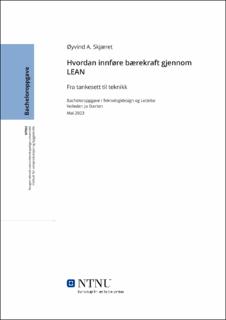| dc.contributor.advisor | Sterten, Jo | |
| dc.contributor.author | Skjæret, Øyvind A. | |
| dc.date.accessioned | 2023-09-11T17:19:36Z | |
| dc.date.available | 2023-09-11T17:19:36Z | |
| dc.date.issued | 2023 | |
| dc.identifier | no.ntnu:inspera:139559735:148618647 | |
| dc.identifier.uri | https://hdl.handle.net/11250/3088729 | |
| dc.description.abstract | Formålet til denne bacheloroppgaven er å bruke metodikken rundt Lean til å innføre bærekraft på en måte som tradisjonell Lean ikke kan. Dette gjøres ved å utvikle en ny metode som kombinerer prinsippene og metodikken til Lean, med etablert veiledning rundt bærekraftig utvikling gitt av FNs bærekraftsmål og ISO 14001. Oppgaven tar også i bruk metode for å lettere innføre kunnskap om bærekraft gjennom SEKI-modellen for kunnskapsformidling.
Målet med metoden er å identifisere miljøsvinn på en arbeidsplass eller i en prosess, som etter Leans prinsipper ikke skaper noen verdi som, i dette tilfelle, hindrer en bærekraftig utvikling i samfunnet. Ved å klare å identifisere disse typene av svinn så kan det tas i bruk tiltak som reduserer eller eliminerer miljøsvinnet fra det aktuelle området, som også er et mål i oppgaven. For måloppnåelse brukes en PUKK-syklus som er tilpasset gjennom bruk av teorigrunnlaget, som så blir anvendt på universitetets egen læringsfabrikk (som er lager for akademiske formål).
Resultatet viser vanskeligheten av å gjøre tiltak uten tilstrekkelig kunnskap eller data som basis for handling. Det viser også hvor rigid læringsfabrikken er i ønske om å gjøre forbedrende tiltak. Til slutt så viser det hvor relevant PUKK-syklusen er i å skape et system for kontinuerlig forbedring og læring, som gjør fremtidige tiltak lettere å innføre. | |
| dc.description.abstract | The purpose of this bachelor’s thesis is to use the methodology of Lean to introduce sustainability in a way that traditional Lean is not able to. This is done by forming a new method that combines the principles and methodology of Lean with established guidance on sustainable development through the United Nations sustainable development goals (SDGs) and ISO 14001.The thesis also delves into theory on how to apply knowledge of sustainability to an environment through the SECI model of knowledge dimensions.
The overall goal of the method is to be able to identify environmental wastes in a workplace or process that, by the principle of Lean is creating no value which, in this case, hinder the sustainable development of society. By first identifying these types of waste, one is able to take further steps to reduce or remove the environmental waste from the area of concern, which is also a goal of the thesis. In order to accomplish the goals a PDCA-cycle is adapted to be used in conjunction with the theory-basis, which is then applied to the university’s own learning factory (which is built for academic purposes).
The overall results show the difficulty of making decisions without sufficient information or data to base decisions on. It also shows the rigidness of the learning factory’s ability to provide or apply correcting measures. It also shows the relative success of using a PDCA cycle when applied to the process of learning that will make future decision-making more feasible. | |
| dc.language | nob | |
| dc.publisher | NTNU | |
| dc.title | Hvordan innføre bærekraft gjennom LEAN - Fra tankesett til teknikk | |
| dc.type | Bachelor thesis | |
